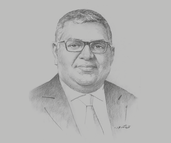Prabhash Subasinghe, Managing Director, Global Rubber: Interview

Interview: Prabhash Subasinghe
What effect has regional competition had on players in Sri Lanka’s rubber industry?
PRABHASH SUBASINGHE: Sri Lanka is faced with significant competition from large economies in the region, such as India, Malaysia and Thailand, which also specialise in the value-added production of rubber products. The automotive tyre industry is valued at $200bn, so it is no surprise that its production demand is substantial.
As it is a comparatively small economy with limited access to resources, Sri Lankan manufacturers are driven towards the niche markets of speciality tyres and solid tyres, valued at $20bn and $2bn, respectively. This has, however, given the Sri Lankan rubber industry the opportunity to identify the specific needs of these markets and tailor their output to align with the specific requirements and consumer demand. This focused approach has aided in exploiting economies of scale and increasing the country’s competitiveness.
How is the industry continuing to cement itself as a global centre for rubber-based products?
SUBASINGHE: Strong regional competition has enabled Sri Lanka to become a world leader in solid tyres, accounting for 60% of the market. The Ministry of Plantation Industries has collaborated with various stakeholders to implement the Sri Lanka Rubber Industry Master Plan 2017-26. Despite raw material supply shortages and intense competition from developed countries that have more access to capital and resources, the plan targets achieving an annual gross industry turnover of nearly $4.4bn by 2025. In order to reach this amount, the industry is estimated to require over $1.5bn of investment in the medium term to augment the existing investment.
In what ways can Sri Lanka reduce its dependence on imported raw materials?
SUBASINGHE: Like other countries in the global marketplace, Sri Lanka relies on the import of raw materials in some sectors. However, natural rubber is widely available in Sri Lanka, which gives a significant competitive advantage to this particular industry. Furthermore, all imports for the rubber industry are tax and duty free, as the government has identified it as a key industry, thereby reducing the cost of importing raw materials from bulk industries. Investment in research and development could help reduce dependency on imported raw materials even further.
What impact will future trade deals have as a growth driver for the industrial sector?
SUBASINGHE: The foremost driver of flourishing international trade would be the eradication of international trade barriers, allowing Sri Lanka to increase its level of productivity and output to the global marketplace. This would enable industries to improve efficiency, allow foreign technology to be utilised and increase investment in research and development. As a result, the country would be able to offer more competitive, innovative and cost-effective products to the world.
How can Sri Lanka maintain an adequately skilled workforce and sufficient productivity?
SUBASINGHE: Increased mechanisation, through the use of modern manufacturing units, is one method currently being implemented. For example, in mid-2018 a computer simulation was created to design advanced rubber products. Mechanisation has reduced labour dependency and also increased the degree of precision in production, contributing to improved consistency in the quality of products, a faster production cycle, reduced waste and a higher level of safety.
Furthermore, Sri Lanka plans to cultivate a workforce that is more diverse in terms of age, ethnicity and gender. Knowledge sharing is the key to survival for any industry. To facilitate this, government and industry organisations have arranged training and development programmes, on both a local and international level.
You have reached the limit of premium articles you can view for free.
Choose from the options below to purchase print or digital editions of our Reports. You can also purchase a website subscription giving you unlimited access to all of our Reports online for 12 months.
If you have already purchased this Report or have a website subscription, please login to continue.

